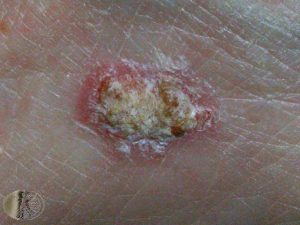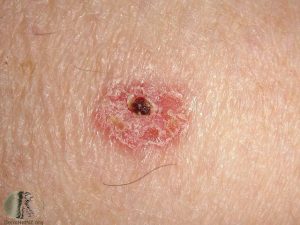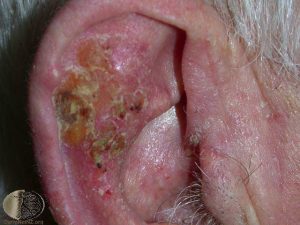
Squamous cell carcinoma (SCC) is a common skin type of skin cancer and most often develops in fair-skinned people on areas of the body that have had sun exposure for many years: face, ears, scalp, neck, arms, back of hands, or the legs. It is possible to get SCC anywhere on the body including inside the mouth, lips, and genitals. People who have used tanning beds or who are on medication that suppresses the immune system are at higher risk of getting SCC. SCC also can appear in non-healing ulcers or wounds, in healed burns or scars, in areas of previous radiation treatment, in areas of skin infected with HPV, after exposure to arsenic or other cancer-causing chemicals, or if someone has had numerous previous PUVA treatments for other skin conditions. Early diagnosis and early treatment of squamous cell carcinoma generally leads to an excellent prognosis.
Typical signs of SCC may include:
- A bump on the skin or lump under the skin that can by dry or feel rough
- A crusty, scaly, red growth on the skin that won’t heal
- A sore that can bleed without injury or feels itchy or painful to the touch
- A flat, red, scaly patch on the skin that may grow slowly
SCC can grow from a pre-cancerous growth called an actinic keratosis (AK). These usually start to form in adults 40 years of age or older, and about 40-60 % of SCC arise from an AK. AKs are usually small pink, rough, dry, or scaly spots on the skin of areas that are exposed to the sun for many years (face, ears, neck, arms, back of hands). These can be itchy or irritated.
Diagnosis of squamous cell carcinoma requires skin biopsy of all or part of the growth by your dermatologist. This is a simple procedure performed during your office visit. Based on results from the biopsy and whether or not the cancer has spread, squamous cell carcinoma treatment options may include:
- Excision: a surgical procedure in the dermatology office removing the SCC including a measured amount of normal skin around the tumor.
- ED&C: a treatment performed in the dermatology office involving scraping away the tumor using electricity to destroy any remaining cancer cells.
- Mohs surgery: a skin-sparing surgical procedure performed in office that involves on-site examination of edges of tissue removed to ensure tumor clearance same day, often used for high-risk tumor subtypes or locations.
- Medicated cream or ointment: imiquimod or 5-fluorouracil may be used alone or in combination with ED&C to treat SCC in certain cases.

Some SCC may not be able to be removed surgically and could require local radiation treatments. If the SCC has spread to lymph nodes or another part of the body, more extensive surgery, radiation, or chemotherapy may be necessary.

Most people who get SCC have an excellent prognosis and can be cured, especially if it is small and caught early. Anyone who has had squamous cell carcinoma has a higher risk for getting another skin cancer, including SCC. It is possible for SCC to recur at the site of previous treatment or to spread despite treatment, so it is important to continue to follow up regularly with your dermatologist if you have a history of this disease. It is important to prevent further damage from sun exposure, which can increase your chance further of getting another SCC or other skin cancer. It is recommended to not smoke or use any tobacco products and to limit the use of alcohol as the use of these two substances increase risk for SCC inside the mouth, which may be aggressive and life threatening. Please ask your dentist to carefully screen for skin cancer inside the mouth.
If you are interested in learning more about squamous cell carcinoma treatment options or scheduling a skin cancer screening, contact the skin experts at Summit Dermatology in Colorado Springs and Monument, CO. Our staff of qualified dermatologists are dedicated to providing you patient centered care that meets your individual skin care needs.
